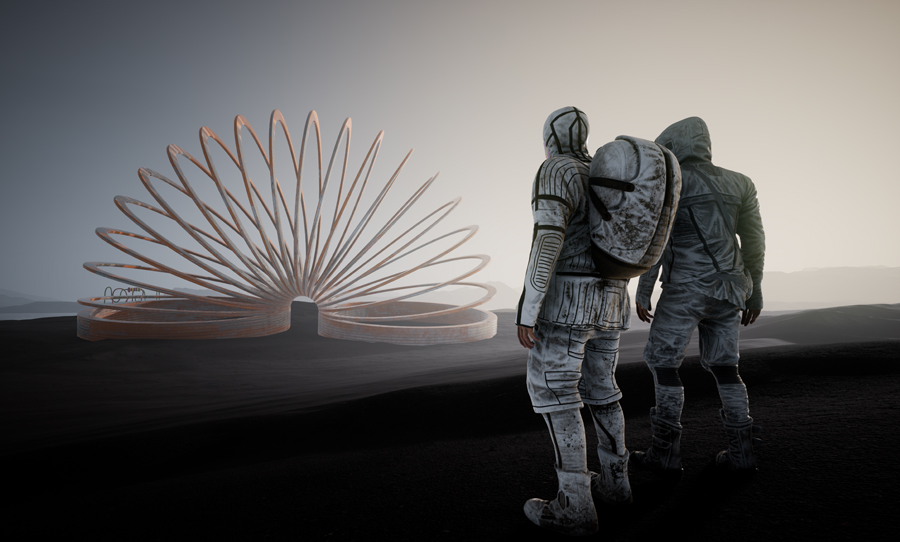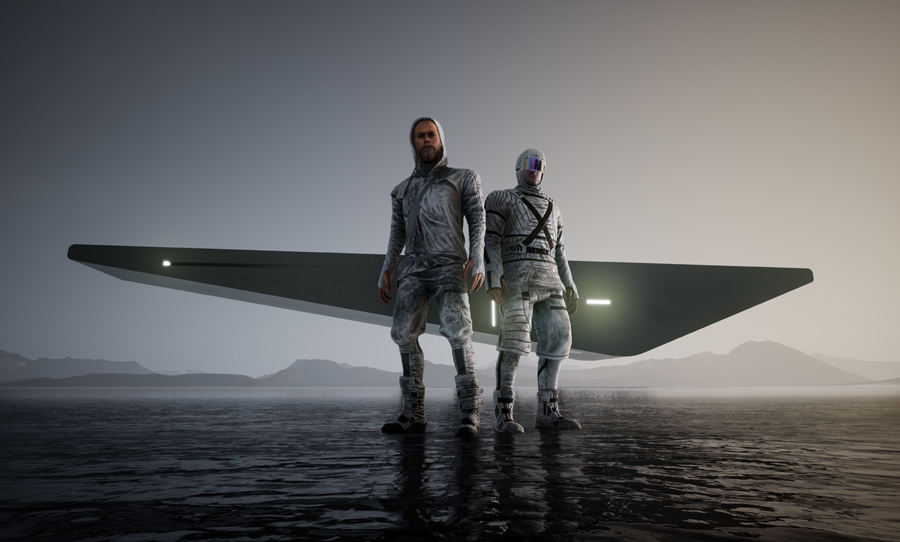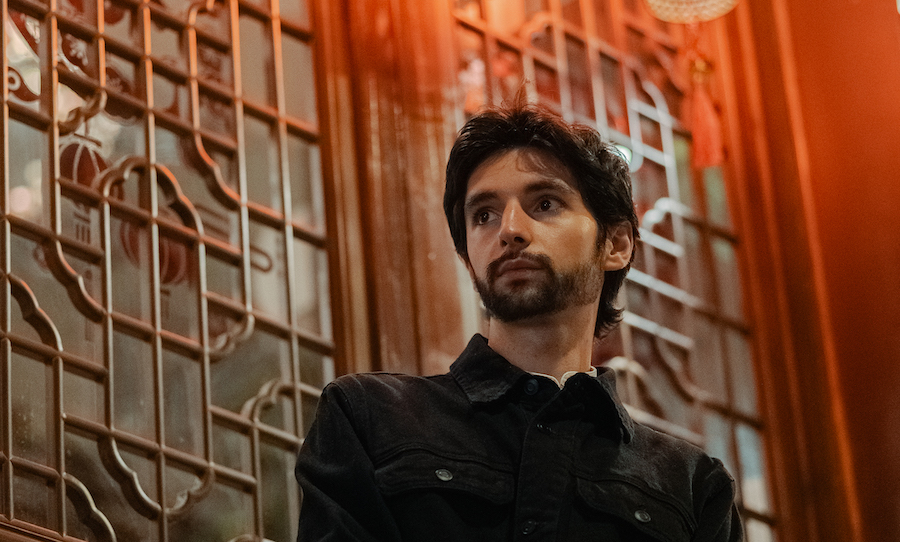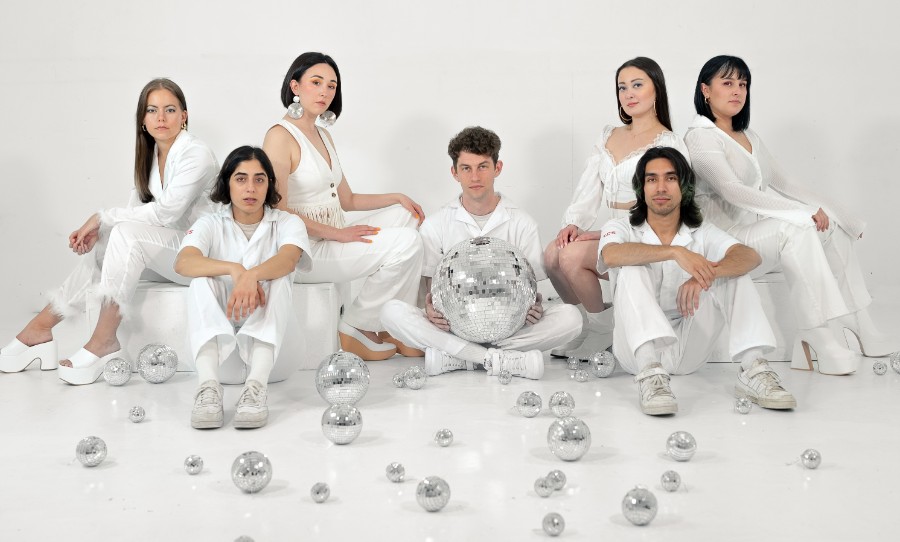A chance encounter drew Jarrad Rogers and Luke Steele together. As H3000, the two artists have been inspiring each other ever since.
Luke Steele (The Sleepy Jackson, Empire of the Sun, DREAMS) and Jarrad Roger (aka Mstr Rogers — a songwriter and producer who has worked with Charlie XCX and Lana Del Rey) are no strangers to fruitful collabs. But with their new project, H3000, these creative forces have combined to imagine a bold future for music, complete with its own visual language.
With an entrancing video set to launch, and a self-titled album slated for September, the anticipation around what this supergroup is capable of is reaching fever pitch. We caught up with the Steele and Rogers to discuss fateful rendezvous, creating unlimited scope for exploration in video game engines, and the tools for creating music from the year 3000.

HAPPY: H3000 seems like an inspired combination, but you come from vastly different musical backgrounds. How did find each other?
JARRAD: Speed dating.
HAPPY: (Laughs) —
LUKE: We met at Henson, the famous Henson Studios. I was doing a DREAMS record with Daniel Johns and we needed some production help. M-Phazes came in and brought Mstr Rogers along and we met there. The guys went upstairs to the ‘B’ room and literally within half an hour, Jarrad came down and said “I’ve got something”. I think he recorded a beat with pencils and some of the Henson notebooks and it sounded incredible.
JARRAD: They didn’t leave us with much, we just had to make do. If you can find a pencil and a notebook, you can make a sick drum kit out of that. It beats sifting through sample packs, that’s so boring.
HAPPY: Absolutely. Limitations are powerful.
JARRAD: Yeah. It was a pretty awesome way to meet. For me, it was like meeting a couple of idols. It was very cool.
HAPPY: And as an audio nerd, I just have to ask, is the name a nod to the Eventide H3000?
LUKE: (Laughs) I don’t know whether we should say that or not.
JARRAD: No! It’s got nothing to do with that. Absolutely nothing!
HAPPY: (Laughs) —
LUKE: Do you remember in Australia growing up there used to be a show called ‘Beyond 2000’? Maybe we’ll just go with that.
JARRAD: Well, it is about the heart in the year 3000, that’s kind of where we landed on it. But yeah, it looked pretty cool on the Eventide.
HAPPY: In July Heat, there’s a glittering, synth-heavy production, but I’m also interested in the raw form of the track. Did it begin with a vocal melody and basic chord progression? How did you guys bring that one to life?
JARRAD: It kinda started with the chopped up, griddy synth part and Luke jammed over that. We very rarely work in the same room together. It actually works for us to be in separate spaces. But when we did meet, I was living in LA. How many times did we work together in the same room, Luke? It was so few. We just ended up going to buy expensive sandwiches and coffee and not being very productive.
It often just takes one little part and if Luke gets inspired, he jams over it. From there it’s kind of a back and forth process to refine what it’s about. I’m realising that it takes genuine inspiration to get Luke inspired on a melodic front, but it doesn’t take much else around that moment of inspiration. It takes just one part that feels inspired then he sends something back that’s pretty amazing.
HAPPY: And the production on that track, in particular, sounds painstakingly accurate, but also fresh and intuitive, what was it like to get those vocals in the box and go to town on them?
LUKE: It was exciting because it’s kind of hyper. I’d come back from Japan and had all these different vocal pedals and we were right into this sort of cut-up sound. It was like we found a secret gadget from the future. We were both into that and Jarrad’s super dope at all the intricate stuff, which I love a lot as well. It was a cool track that one.
JARRAD: It was one of the examples of a pretty collaborative production process. Luke comes from a pretty different place production-wise to me, but we meet in the middle pretty nicely. It’s very rare that one of us will do something and the other person will say ‘that sucks’. I love it when anything gets sent over from Luke. Firstly, it’s gonna be sick and secondly, I would never have thought of that.
HAPPY: And Luke, you mentioned a couple of pieces of futuristic gear: were there any pieces that you two were vibing on in the production of these tracks?
LUKE: I love the gender-warping stuff, that you get on the (TC Electronic) Helicon that we used heaps. And drawing in gender through Auto-Tune is something that I’ve been doing. Everyone’s doing that vocal cut-up thing now, but that’s something I’ve always wanted to do. Kind of what Skrillex does so good is putting different samples on a MIDI controller and bouncing it around. We used a bit of the Vocoder, the VP-330, I love those old vocoders.
JARRAD: I think it’s a mix of old and new, always. DAWs these days are so futuristic in themselves: it’s ridiculous what you can do. But it’s gotta get out of that as well and you gotta bring some heritage to it as well.

HAPPY: You got Collider onboard to work on the video for Running. Was there anything significant about the video game aesthetic that you wanted to tap into?
JARRAD: We like the idea of the avatar. That was probably where it began. And there’s freedom in creating in video game worlds. It’s almost limitless if you know what I mean. Once you’ve got that world built, there’s so much you can do with it. And there’s so much you can do with it after the video as well. Often, you shoot a video and that’s it. You might be able to get some behind the scenes reel out of it, but that can be a bit boring.
But when you build it in a video game engine, who the hell knows what we can do with it? We could make our own game so fans can walk around in it, they can find merch in it, they can find hidden tracks. Maybe it could be a treasure hunt for hidden tracks like on old-school albums? 10 minutes later, do you remember that? When a CD would just play this new track?
LUKE: It just worked so well with the sound of the record. We were kind of wondering how we’d get to that place and what it sounds like. It was quite natural, the way Collider came in. They just smashed it out of the park.
HAPPY: And when you see the music interpreted in such a striking way, does it inspire new sounds?
JARRAD: I don’t think it’s done that for me, but visual always comes second for me. I was listening to a podcast this morning: Rick Rubin’s ‘Broken Record’. There’s was one with Pharrell on there and he really sees music in colours. He was talking about “this chord was really blue” and I thought, “I gotta go and read a book and find out what blue chords sound like!”
It really comes second to me, but Luke is way more visual than me. I’ll have suggestions, but I’ll hold on to them very lightly because often, I’m wrong (laughs).
LUKE: It’s funny, the great paradox of music. You go into the studio and say, “let’s make something Japanese, fast, 180 bpm!” And then you end up writing a ballad at 82 bpm. So it might affect us in different ways. The next bunch of music might have no effects, acoustic guitar with Auto-Tune on it and that’s the future.
JARRAD: Who knows? We’ve barely scratched the surface. But maybe it is that. I sometimes think, “man, I wanna see what H3000 feels like with organic instruments.” Maybe it’s the over-saturation of the unreal side of things, the super, hyper-reality. What would it be like if it was just in a forest? Just a little log cabin and that’s it. What could we do then?
HAPPY: And are you planning to bring the H3000 show to the stage?
JARRAD: Heck yeah! Have you seen one of Luke’s shows?
HAPPY: Yes! Even way back in the Sleepy Jackson days.
LUKE: (Groans) —
JARRAD: It’d be a crime not to put this band on the stage!
LUKE: We started designing something the other day and it would really cool to take it out.
JARRAD: It’s one of those records that might be confusing at some points, but when you hear it live, it’s just gonna join the dots. With music that pushes the boundaries, you realise that hearing and feeling it in that live setting is when people can really understand it.



